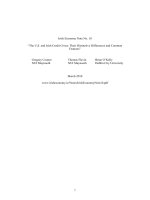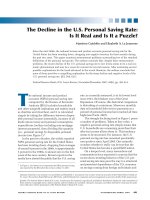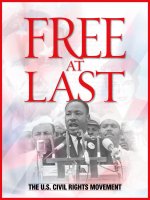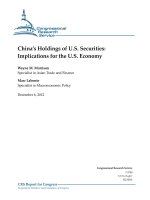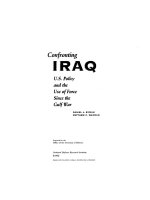The U.S. Scientific and Technical Workforce ppt
Bạn đang xem bản rút gọn của tài liệu. Xem và tải ngay bản đầy đủ của tài liệu tại đây (1.08 MB, 134 trang )
CHILDREN AND ADOLESCENTS
CIVIL JUSTICE
This PDF document was made available from www.rand.org as a public
service of the RAND Corporation.
EDUCATION
ENERGY AND ENVIRONMENT
HEALTH AND HEALTH CARE
Jump down to document6
INTERNATIONAL AFFAIRS
POPULATION AND AGING
PUBLIC SAFETY
SCIENCE AND TECHNOLOGY
SUBSTANCE ABUSE
TERRORISM AND
HOMELAND SECURITY
The RAND Corporation is a nonprofit research
organization providing objective analysis and effective
solutions that address the challenges facing the public
and private sectors around the world.
TRANSPORTATION AND
INFRASTRUCTURE
U.S. NATIONAL SECURITY
Support RAND
Purchase this document
Browse Books & Publications
Make a charitable contribution
For More Information
Visit RAND at www.rand.org
Explore RAND Science and Technology
View document details
Limited Electronic Distribution Rights
This document and trademark(s) contained herein are protected by law as indicated in a notice
appearing later in this work. This electronic representation of RAND intellectual property is provided
for non-commercial use only. Permission is required from RAND to reproduce, or reuse in another
form, any of our research documents for commercial use.
This product is part of the RAND Corporation conference proceedings series. RAND
conference proceedings present a collection of papers delivered at a conference. The
papers herein have been commented on by the conference attendees and both the introduction and collection itself have been reviewed and approved by RAND Science
and Technology.
The U.S. Scientific and
Technical Workforce
Improving Data for Decisionmaking
Terrence K. Kelly, William P. Butz, Stephen Carroll,
David M. Adamson, Gabrielle Bloom, editors
CF-194-OSTP/SF
June 2004
Prepared for the Office of Science and Technology Policy and
the Alfred P. Sloan Foundation
Approved for public release; distribution unlimited
The research described in this report was conducted by the Science and Technology Policy
Institute (operated by RAND from 1992 through November 2003) for the Office of Science
and Technology Policy under Contract ENG-9812731 and the Alfred P. Sloan Foundation.
ISBN: 0-8330-3651-3
The RAND Corporation is a nonprofit research organization providing objective analysis
and effective solutions that address the challenges facing the public and private sectors
around the world. RAND’s publications do not necessarily reflect the opinions of its research
clients and sponsors.
Rđ is a registered trademark.
â Copyright 2004 RAND Corporation
All rights reserved. No part of this book may be reproduced in any form by any electronic or
mechanical means (including photocopying, recording, or information storage and retrieval)
without permission in writing from RAND.
Published 2004 by the RAND Corporation
1700 Main Street, P.O. Box 2138, Santa Monica, CA 90407-2138
1200 South Hayes Street, Arlington, VA 22202-5050
201 North Craig Street, Suite 202, Pittsburgh, PA 15213-1516
RAND URL: />To order RAND documents or to obtain additional information, contact
Distribution Services: Telephone: (310) 451-7002;
Fax: (310) 451-6915; Email:
Preface
About This Document
The U.S. scientific, technical, engineering, and mathematics (STEM) workforce makes key
contributions to the nation’s economic growth, national security, and other national goals.
Given the importance of this workforce, monitoring and understanding its health and
vitality are in the national interest. In 2003, a RAND Corporation study examined the issue
of potential labor shortages in this workforce, which has been a recurring concern in federal
policy circles since the 1950s. The study posed two questions: Are the current data on this
workforce adequate to support relevant decisionmaking and, if not, what improvements are
necessary?
To address this issue, the Office of Science and Technology Policy (OSTP) and the
Alfred P. Sloan Foundation asked RAND to convene a technical conference to discuss the
current state of data gathering on the U.S. STEM workforce and how data for decisionmaking might be improved. The conference included participants from federal research and
development (R&D) and statistical agencies and researchers from universities and foundations. This volume provides each paper delivered at the conference, as well as three sections
that RAND analysts prepared: an introduction, a rapporteur’s summary, and list of priority
data needs. The RAND materials have been peer-reviewed and edited. The conference
papers, however, have not been peer reviewed and have been edited only for formatting and
stylistic consistency.
The conference proceedings should be of interest to the science and technology policy community, science and math educators, students assessing career paths, and analysts
interested in data and statistical issues.
Related RAND documents include
• William P. Butz, Gabrielle A. Bloom, Mihal E. Gross, Terrence K. Kelly, Aaron
Kofner, and Helga E. Rippen, “Is There a Shortage of Scientists and Engineers? How
Would We Know?” Santa Monica, Calif.: RAND Corporation, IP-241-OSTP,
2003. Online at />• William P. Butz, Terrence K. Kelly, David M. Adamson, Gabrielle A. Bloom, Donna
Fossum, and Mihal E. Gross, Will the Scientific and Technical Workforce Meet the
Requirements of the Federal Government? Santa Monica, Calif.: RAND Corporation,
MG-118-OSTP, 2004. Online at />
iii
iv
The U.S. Scientific and Technical Workforce: Improving Data for Decisionmaking
About the Office of Science and Technology Policy
The Office of Science and Technology Policy (OSTP) was created in 1976 to provide the
president with timely policy advice and to coordinate the federal investment in science and
technology.
About the S&T Policy Institute
Originally created by Congress in 1991 as the Critical Technologies Institute and renamed
in 1998, the Science and Technology Policy Institute is a federally funded research and
development center sponsored by the National Science Foundation. The S&TPI was
managed by RAND from 1992 through November 30, 2003.
The Institute’s mission is to help improve public policy by conducting objective,
independent research and analysis on policy issues that involve science and technology. To
this end, the Institute
• supports the Office of Science and Technology Policy and other Executive Branch
agencies, offices, and councils
• helps science and technology decisionmakers understand the likely consequences of
their decisions and choose among alternative policies
• helps improve understanding in both the public and private sectors of the ways in
which science and technology can better serve national objectives.
In carrying out its mission, the Institute consults broadly with representatives from
private industry, institutions of higher education, and other nonprofit institutions.
Inquiries regarding the work described in this document may be directed to the
address below.
Debra Knopman
Assistant Director
RAND Science and Technology
1200 South Hayes Street
Arlington, VA 22202-5050
Tel: 703.413.1100, ext. 5667
Web: www.rand.org/scitech
Contents
Preface ..................................................................................................iii
Figures ..................................................................................................ix
Tables...................................................................................................xi
Acknowledgments .................................................................................... xiii
Abbreviations .......................................................................................... xv
PART I
Prologue
CHAPTER ONE
Introduction ........................................................................................... 3
Overview ............................................................................................... 3
STEM Workforce Shortages: A Recurring Concern ................................................... 4
Improving the Data System for Decisionmaking ...................................................... 6
Organization of This Document ....................................................................... 7
References .............................................................................................. 8
PART II
Contributed Papers
CHAPTER TWO
Do We Need More Scientists?
Michael S. Teitelbaum ............................................................................. 11
A History of Gloomy Forecasts ....................................................................... 11
The Evidence .......................................................................................... 13
What Does the Future Hold? ......................................................................... 15
Misdirected Solutions ................................................................................. 15
Opportunity Costs .................................................................................... 17
The Politics of Shortages .............................................................................. 18
References ............................................................................................. 19
CHAPTER THREE
What Will It Take for the United States to Maintain Global Leadership in
Discovery and Innovation?
Michael P. Crosby and Jean M. Pomeroy........................................................... 21
Abstract ................................................................................................ 21
Introduction ........................................................................................... 21
v
vi
The U.S. Scientific and Technical Workforce: Improving Data for Decisionmaking
Data Needs for Policy and Planning .................................................................. 22
An Appropriate Focus for a National Dialogue ....................................................... 22
Common Definitions ................................................................................. 24
Global S&E ........................................................................................... 25
Summary and Conclusion ............................................................................. 26
References ............................................................................................. 26
CHAPTER FOUR
Does America Face a Shortage of Scientists and Engineers?
Ronald Ehrenberg .................................................................................. 28
References ............................................................................................. 31
CHAPTER FIVE
Data! Data! My Kingdom for Data! Data Needs for Analyzing the S&E Job Market
Richard B. Freeman ............................................................................... 32
Data Use Determines Data Needs .................................................................... 33
Data Gathering for Monitoring ....................................................................... 35
Weakness of Data for Supply Behavior ............................................................... 37
Weaknesses of Data on Demand and Production of Basic and Applied Knowledge ................. 40
Ten Suggestions ....................................................................................... 41
References ............................................................................................. 44
CHAPTER SIX
What Data Do Labor Market Researchers Need? A Researcher’s Perspective
Paula E. Stephan .................................................................................. 45
Introduction ........................................................................................... 45
Doctoral Workforce ................................................................................... 46
For Whom? ......................................................................................... 46
What Kinds of Data? ............................................................................... 46
Productivity ........................................................................................ 48
Timely Release of Data ............................................................................. 49
Access Is Important................................................................................. 49
Summary of Needs .................................................................................... 49
References ............................................................................................. 49
CHAPTER SEVEN
What Data Do Science, Technology, Engineering and Mathematics (STEM) Agency
Policymakers Need?
Judith A. Ramaley ................................................................................. 51
Phase 1 Agenda Setting: The Overall Functions of the National Science Foundation ............... 51
Phase 2 Formulation and Selection of Goals: The Goals of the National Science Foundation ....... 52
Phase 3A Program Implementation: A Capsule Portrait of the Education and Human
Resources Directorate at the National Science Foundation ...................................... 52
Phase 3B Program Implementation: Workforce for the 21st Century Priority Area ................. 54
Phase 4 Evaluation and Assessment of Impact of Programs and Phase 5: Decisions
About the Future of Policy and Programs ........................................................ 54
Reference .............................................................................................. 59
Contents
vii
CHAPTER EIGHT
What Data Do STEM Agency Policymakers Need? Workforce Planning for the Future:
The NASA Perspective
Patrick Simpkins................................................................................... 60
Data as Part of an Integrated Picture .................................................................. 60
Types and Sources of Data for the Workforce of Today and Tomorrow ............................. 63
Assessing Workforce Competencies ................................................................ 63
The Future Workforce Pipeline Issues ............................................................. 63
Use of Data in Human Capital Management Decisionmaking ....................................... 64
Types, Sources, and Improvements in Workforce Planning and Analysis Data—
Some Opportunities .............................................................................. 65
References ............................................................................................. 67
CHAPTER NINE
Meeting the Data Needs: Opportunities and Challenges at the National
Science Foundation
Lynda T. Carlson .................................................................................. 69
Introduction ........................................................................................... 69
Background to the Data Collections .................................................................. 69
The Survey of Earned Doctorates ..................................................................... 70
Scientists and Engineers—The SESTAT System ..................................................... 70
The SESTAT System for This Decade ................................................................ 72
Improving the SESTAT Sample Designs ............................................................. 73
Informing the S&E Workforce Policy Issues.......................................................... 74
Do NSF Data Systems Inform the Policy Issues? What Are the Challenges
for This Decade? .................................................................................. 75
Improvements Under Way to Enhance the Capabilities of NSF Data Collections ................... 77
Foreign Scientists and Engineers in the United States: The Challenge of Keeping
the Data Current.................................................................................. 80
The Challenges ........................................................................................ 80
References ............................................................................................. 80
CHAPTER TEN
Opportunities and Challenges at the Bureau of Labor Statistics
Michael W. Horrigan .............................................................................. 82
Summary .............................................................................................. 89
CHAPTER ELEVEN
U.S. Census Bureau Data and the Science and Technology Workforce
Comments by Robert Kominski..................................................................... 90
Reference .............................................................................................. 92
CHAPTER TWELVE
Opportunities and Challenges at the National Center for Education Statistics
C. Dennis Carroll .................................................................................. 93
Abstract ................................................................................................ 93
Introduction ........................................................................................... 93
viii
The U.S. Scientific and Technical Workforce: Improving Data for Decisionmaking
Coding Program and Major Field of Study ........................................................... 95
Science and Technology Data Within NCES Studies ................................................ 95
The Good News ....................................................................................... 95
The Bad News ......................................................................................... 96
Summary .............................................................................................. 96
References ............................................................................................. 96
PART III
Summary and Conclusions
CHAPTER THIRTEEN
Rapporteur’s Summary
William P. Butz ................................................................................... 99
Decisionmakers in the Markets for STEM Workers .................................................. 99
Policymakers in Science Funding Agencies ........................................................ 99
Program and Human Resource Administrators in Federal and Other Public
Agencies That Employ Scientists and Engineers............................................... 99
Private-Sector Employers, Colleges, and Universities ............................................ 100
Members of the STEM Workforce............................................................... 100
Students and Their Advisors ..................................................................... 100
Labor Market Researchers ........................................................................ 100
Crosscutting Themes ................................................................................ 101
A Broader Context: General STEM Competency ............................................... 101
Revisiting Key Assumptions About Training and Careers ....................................... 101
Data Coordination and Collection Issues ........................................................ 101
Identifying Workforce Shortages and Surpluses ................................................. 102
The Global Dimension ........................................................................... 103
What Data Do Decisionmakers Require? What Data Can Producers Supply? ..................... 103
Concluding Observations ........................................................................... 106
CHAPTER FOURTEEN
Priority Data Improvements ...................................................................... 107
Current Job Market Conditions..................................................................... 107
Comparative Graduate Program Data .............................................................. 107
Private Industry Data................................................................................ 108
STEM Career Paths ................................................................................. 108
Global Workforce ................................................................................... 108
Moving Forward..................................................................................... 109
APPENDIX
A. Conference Agenda ............................................................................ 111
B. Biographical Notes on Contributors ......................................................... 113
Figures
3.1. Women and Underrepresented Minorities Are Less Likely to Earn Bachelor’s
Degrees in NS&E ............................................................................ 23
3.2. Foreign-Born Workers Account for an Increasing Share of the U.S.
S&E Workforce .............................................................................. 24
3.3. NSB Defines the S&E Workforce Broadly................................................... 25
5.1. Oscillations in Enrollments in Engineering, Fiscal Years 1946–2001 ....................... 38
8.1. NASA Strategic Human Capital Architecture ............................................... 62
8.2. Integrated Workforce Information Processes ................................................ 65
ix
Tables
5.1. Alternative Estimates of the Proportion of Scientists and Engineers
Who Are Foreign-Born, by Degree .......................................................... 36
5.2. Ten Suggestions for Improving the Database and Analysis of the Science
and Engineering Workforce .................................................................. 42
8.1. Competencies Representing NASA’s Critical Needs: 4th Quarter,
FY 2004 Analysis ............................................................................. 67
10.1. Employment and Nominal Wage Change for All Workers and for
Selected Engineering Occupations, 1994 to 2000 ........................................... 85
10.2. Experienced Unemployment Rate for All Workers and for Mechanical
and Industrial Engineers, 1994 to 2000...................................................... 86
10.3. Percent Distribution of All Workers and Mechanical and Industrial
Engineers, by Selected Characteristics, 1994–1996 to 1998–2000 .......................... 87
10.4. Employment by Selected Occupation, 2002 and Projected 2012 ........................... 88
xi
Acknowledgments
The authors wish to thank the conference participants for their contributions to the event
and to this document. We would also like to thank our reviewers, Charles Goldman and
Roger Benjamin of RAND, for their thoughtful comments and questions, as well as Debra
Knopman and Steven Popper of RAND S&T for their insights. We also owe thanks to Lisa
Sheldone of RAND S&T for coordinating peer reviews and publication; to Phyllis Gilmore
for her careful and rigorous editing; and, last but not least, to Mary DeBold for her tireless
assistance in organizing the conference and in helping us produce this document.
xiii
Abbreviations
AA
ACS
AGEP
B&B
BEST
BLS
BPS
BS
CCLI
CED
CHERI
CIP
CMS
CNSTAT
CPS
CPST
DAS
DGE
DHS
DNA
EHR
ELS
EPSCoR
EU
GAO
GK–12
GPRA
GRF
associate in arts
American Communities Survey
Alliance for Graduate Education and the Professoriate
Baccalaureate and Beyond
Building Engineering and Science Talent
Bureau of Labor Statistics
Beginning Postsecondary Students
bachelor of science
Course, Curriculum, and Laboratory Improvement
Committee for Economic Development
Cornell Higher Education Research Institute
Classification of Instructional Programs
Competency Management System
Committee on National Statistics
Current Population Survey
Commission on Professionals in Science and Technology
Data Analysis Systems
Division of Graduate Education (NSF)
Department of Homeland Security
deoxyribonucleic acid
Education and Human Resources Directorate
Education Longitudinal Study of 2002
The Experimental Program to Stimulate Competitive Research
European Union
General Accounting Office
Graduate Teaching Fellows in K-12 Education program (NSF)
Government Performance Results Act (1993)
Graduate Research Fellowships (NSF)
xv
xvi
The U.S. Scientific and Technical Workforce: Improving Data for Decisionmaking
GSS
GUIRR
IERI
IGERT
IPEDS
IT
ITAA
K–12
LED
LSAMP
MBA
MORG
MS
NAS
NASA
NBER
NCES
NDEA
NELS
NIH
NPSAS
NRC
NS&E
NSB
NSCG
NSF
NSOPF
NSRCG
OECD
OMB
OSTP
PhD
R&D
R&RA
RETA
Survey of Graduate Students and Postdoctorates in Science and
Engineering
Government-University-Industry Research Roundtable
Interagency Education Research Initiative, a joint initiative by the National
Science Foundation and the Department of Education to Support
scientific research that studies educational interventions.
Integrative Graduate Education and Research Traineeship program (NSF)
Integrated Postsecondary Education Data System
information technology
Information Technology Association of America
kindergarten through 12th grade
Longitudinal Establishment Data
Louis-Stokes Alliances for Minority Participation
master of business administration
Merged Outgoing Rotation Group
master of science
National Academy of Sciences
National Aeronautics and Space Administration
National Bureau of Economic Research
National Center for Education Statistics
National Defense Education Act of 1958
National Education Longitudinal Study
National Institutes of Health
National Postsecondary Student Aid Study
National Research Council
natural science and engineering
National Science Board
National Survey of College Graduates
National Science Foundation
National Study of Postsecondary Faculty
National Survey of Recent College Graduates
Organisation for Economic Co-operation and Development
Office of Management and Budget
Office of Science and Technology Policy
doctor of philosophy
research and development
research and related activities
Research, Evaluation and Technical Assistance
Abbreviations
ROLE
S&E
S&T
S&TPI
SBE
SDR
SED
SEI
SESTAT
SEVIS
SHCP
SOC
SRS
STEM
STEP
SUNY
Thomson ISI
TPC
UIUC
UNESCO
U.S.C.
USSR
WMPD
Research on Learning and Education
science and engineering
science and technology
Science and Technology Policy Institute
Social, Behavioral and Economic Sciences
Survey of Doctorate Recipients
Survey of Earned Doctorates
Science and Engineering Indicators
Scientists and Engineers Statistical Data System (a comprehensive system
of information about scientists and engineers in the United States,
maintained by NSF)
Student and Exchange Visitor Information System
Strategic Human Capital Plan
Standard Occupational Classification
Science Resources Statistics
scientific, technical, engineering, and mathematics
Science and Technology Expansion Program
State University of New York
A data resource firm that provides information for scholarly research; a
subsidiary of the Thomson Corporation
Teacher Professional Continuum
University of Illinois at Urbana-Champaign
United Nations Educational, Scientific, and Cultural Organization
United States Code
Union of Soviet Socialist Republics
Women, Minorities and Persons with Disabilities in Science and
Engineering
xvii
Part I
Prologue
CHAPTER ONE
Introduction
Overview1
Among many knowledgeable observers, the size and adequacy of the U.S. scientific, technical, engineering, and mathematics (STEM) 2 workforce have been recurring concerns. There
are fears that the U.S. STEM workforce is aging and that its labor pool may soon dwindle.
There are parallel fears that looming shortfalls in key skill areas may erode U.S. leadership in
some science and engineering fields and that the growing proportion of non-U.S. citizens
obtaining STEM degrees in the United States could complicate the task of mobilizing U.S.
scientific and technological manpower for homeland security. However, evidence for these
periodically anticipated shortages in the general STEM workforce has been hard to find.
Indications of resulting national crises have, so far, been even less evident.
The failure of previously anticipated STEM workforce shortages to materialize
should not be grounds for complacency. Were such shortages to arise, the implications could
be serious, perhaps more so now than in earlier decades, because of the increasingly global
demand for scientific and technical skills, the rise of formidable new competitors (such as
China and India) in scientific and technological fields, and threats to homeland security. The
continuing low entry rate of female and minority students into many STEM fields, noted
particularly in National Science and Technology Council (2000) and National Science
Board (NSB, 2003), also has serious implications. No less damaging for those affected are
unemployment, underemployment, and clogged career tracks that greet new STEM graduates in fields when job growth is slow.
The implications of possible shortages and surpluses justify timely monitoring and
examination of the STEM workforce in the United States. But the data needed to evaluate
and assess STEM workforce trends and patterns and the available STEM jobs have often
been inadequate for informed and timely policymaking.
In response to these data limitations, the Office of Science and Technology Policy
(OSTP), in conjunction with the Sloan Foundation, asked the RAND Corporation to organize a blue-ribbon conference to identify the limitations of the available STEM workforce
data and the opportunities for improving these data. The workshop brought leading
____________
1 This
overview draws from recent RAND Corporation work, including Butz et al. (2003) and Butz et al. (2004).
2 This
workforce includes workers at all educational levels who perform functions in these fields (e.g., computer technicians
whose highest formal degree is a high-school diploma, practicing engineers, medical doctors, and research scientists). It does
not include those with degrees in STEM fields who are not currently working in STEM occupations.
3
4
The U.S. Scientific and Technical Workforce: Improving Data for Decisionmaking
researchers, science agency policymakers, and statistical agency experts together to address
the following question: “How can we improve the data system for decisionmaking with
respect to the U.S. STEM workforce?” This volume contains the proceedings of that conference, consisting of the papers delivered and discussed at the workshop, as well as RAND’s
synthesis of STEM workforce data needs and opportunities for meeting those needs.
STEM Workforce Shortages: A Recurring Concern
Alarms over the numbers of STEM personnel graduating and working in the United States
have been raised on numerous occasions. The earliest alarm, triggered by Sputnik and
accompanied by concerns about K–12 education in the United States, led to landmark federal legislation, the National Defense Education Act of 1958 (NDEA). The federal government dramatically increased funding for science and engineering education, resulting in the
production of more newly trained scientists and engineers than there were jobs available
during the early 1970s.
More recently, in the mid-1980s, the National Science Foundation (NSF) predicted
“looming shortfalls” of scientists and engineers. No such shortfalls occurred and subsequent
government hearings criticized the NSF for releasing these predictions.
Roughly a decade later, the Information Technology Association of America (ITAA)
projected massive shortfalls in the availability of information technology workers. The Office
of Technology Assessment (1988), relying on the ITAA analyses, echoed their warnings of
future shortfalls of STEM workers. Again, there is no evidence that the predicted shortfalls
occurred. A General Accounting Office (GAO) assessment of these projections criticized the
methods used to develop them and the data on which they were based.
Various organizations have continued to examine the STEM workforce and have
argued that their results imply growing gaps between the numbers of positions that require
STEM workers and the numbers of STEM workers available. These organizations include
the Institute of Medicine (1995), the National Research Council (2000a), and the National
Science and Technology Council (2000).
In view of an “unfolding crisis for U.S. science and technology,” a task force of the
NSB called for “a coordinated response to meet our long-term needs for science and engineering skills in the U.S. workforce” (NSB, 2003, p. 1). The report went on to recommend a
national policy imperative, stating that “all stakeholders must mobilize and initiate efforts
that increase the number of U.S. citizens pursuing science and engineering studies and
careers” (NSB, 2003, p. 2).3
What are the likely causes of these supposed shortfalls? Sputnik raised a red flag
about the quality of American education and the need for a stronger federal role in improving STEM education in particular. More-recent concerns about the STEM workforce have
arisen for other reasons. One has been the rapid emergence of new high-technology fields,
such as information technology and genomics, fields that are deemed important for national
competitiveness and security and that require technically trained workers. Another reason is
the increasing technical demands of jobs that, even in traditional manufacturing and service
____________
3
Michael Crosby, NSB Executive Officer and NSB Office Director, also discussed the NSB report during the workshop
(see Dr. Crosby’s paper in Part II).
Introduction
5
industries, call for workers with higher levels of technical training. Other reasons for concern
have focused on the education pipeline—the gradually decreasing numbers of master of science degrees and doctorates awarded in several STEM fields, compared to the increasing
requirements that are sometimes predicted.
Another related challenge, emphasized in the recent NSB report, is the long-term
decline in the proportion of U.S. citizens among STEM doctorates that American institutions grant. It is argued that this trend has potentially ominous implications for the future of
American leadership in science and engineering and that the trend could make it difficult to
meet any increased demand for STEM professionals from national security and homeland
security fields, whose duties require security clearances.
Diverse reasons have been offered for the decline in the proportion of U.S. citizens
earning doctorates at U.S. institutions:
• Preparation for and interest in science careers in K–12 classrooms in the United
States has declined.
• Recent long economic expansions have made the immediate postbaccalaureate job
market increasingly attractive to potential graduate students.
• Careers in medicine, dentistry, veterinary medicine, law, business, and other professional fields, which compete with science for bright U.S. undergraduates, have
become relatively more popular.
• Because the time invested in graduate and postdoctoral training has increased, so have
the opportunity costs of preparation for entry into science careers.
• Demographic trends also have an effect—specifically, minority populations (such as
Hispanics and African-Americans) that, for a variety of reasons, have traditionally
been less likely to pursue STEM careers have grown.
Other possible causes for the decline in the number and proportion of U.S. citizens earning
STEM doctorates have overseas roots. For example,
• The increasing attractiveness of holding a doctorate earned in the United States could
lead more foreign students to apply to U.S. universities, thus displacing U.S. students.
• The international professional networks that have been established over decades have
had a snowball effect, with a growing stream of top foreign candidates applying to
work with their U.S. mentors and friends.
• Foreign science students increasingly desire to live and work in the United States after
training here.4
However, many of these claims of shortfalls are suspect or are based on metrics that
must be taken in context. Viewed broadly since the 1950s, evidence for the periodically
anticipated shortages in the general STEM workforce has been hard to find. Indications of
____________
4 However,
the number of foreign students applying to U.S. graduate schools has declined in the wake of visa rule changes
following September 11, 2001. If this development becomes a long-term trend, it could affect the labor pool for the U.S.
STEM workforce. See, for example, a recent survey conducted by the Council of Graduate Schools, which reported that
graduate applications from international students have declined at more than 90 percent of U.S. universities for the fall
2004 term, and the number of submissions fell 32 percent from 2003 (“New Survey Confirms Sharp Drop in Applications
to U.S. Colleges from Foreign Graduate Students,” 2004). There have also been concerns that foreign students who would
once have applied to U.S. universities might instead be choosing universities in the United Kingdom and Australia (Associated Press, 2003).

